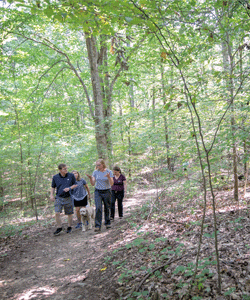My wife, Annette, and I were bounding down the Duke Forest trail, our dogs pulling us between squirrels and startled birds, when our guide called for us to stop next to an ordinary-looking beech tree. “Look closely,” she said. “They’re dancing.”
Annette and I peered in. Sure enough, thousands of aphids, like tiny puffballs, were scurrying along a branch, gleefully eating sap in symbiotic harmony with the fungus growing at the bottom of the tree. The branch looked like it was covered in fresh snow, but it was jiggling ever so slightly as the bugs made their way along.
Here, just four miles from Duke Chapel, we’d discovered a complex biological system—one quaking with life.
We surely would have passed this scene by were it not for our sharp-eyed guide, Duke Forest Director Sara Childs. She oversees conservation, research, and recreation in Duke’s 7,000 acres of protected woodlands. But on this morning in August, she seemed happy to play host to me, Annette, and our dogs, Scout and Cricket.
We began our tour just inside a gate to the Korstian Division, a vast tract that falls on both sides of New Hope Creek. This area, which spans 1,800 acres in northern Orange County, was part of the original land purchased by Duke to serve as a forested teaching and research laboratory.
In those early years, the hills were rutted with the scars of subsistence agriculture, but the forest has made a remarkable comeback in the eight decades under Duke conservation. The managed growth of the pines first planted by Duke Forestry professor Clarence Korstian has allowed for the recovery of hardwoods, which in turn support a renewed ecosystem of plants and animals.
“It’s a goldmine and a treasure in this area, largely untouched since 1931 except for some pockets of active forest management,” Sara told us. “We’re able to conserve and protect many plants and animals that are disappearing from Central North Carolina.”
As we approached a large rocky bluff overlooking the creek, she showed us one example: Catawba Rhododendron. We tend to associate rhododendron with the Blue Ridge mountains, two hundred miles to the west. But this threatened species has been native to the area since the last Ice Age, and Sara and her team are now working with the North Carolina Botanical Gardens to preserve this ancient survivor.
The geology of the Korstian Division shows more evidence of this ancient Duke history. The terrain was carved some 660 million years ago, and the flow of what is now New Hope Creek created the plateau of rock that is now home to West Campus.
A few thousand millennia later, the connection to campus is strong. Nicholas School faculty and students engage in forest management, including controlled burns to promote hardwood regeneration and to manage pine stands. Stream scientists measure the water quality of New Hope Creek, which is at its cleanest when it leaves the forest. Engineers test fly their drones in a Duke Forest meadow. And tens of thousands of members of the Duke community head to the forest each year to hike, run, mountain bike, horseback-ride, fish, and, yes, walk their dogs—on leashes, of course.
Scout and Cricket bid their farewells to the squirrels and birds, and Sara led us back to the trailhead for the quick trip back to West Campus. All around us, I noticed now, the forest was full of life, from the whir of the cicadas to the lichens clinging to the hardwoods. I knew then that we would be back soon—and often—to continue our exploration of this special place.

Share your comments
Have an account?
Sign in to commentNo Account?
Email the editor